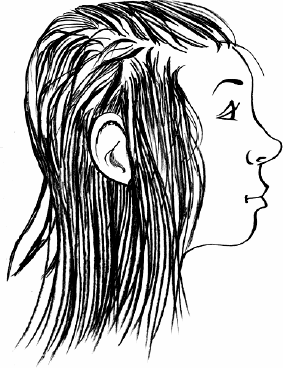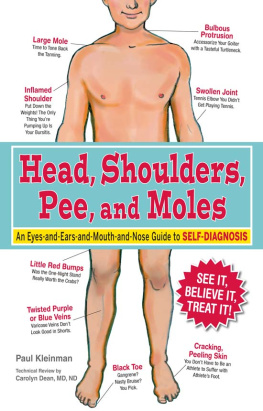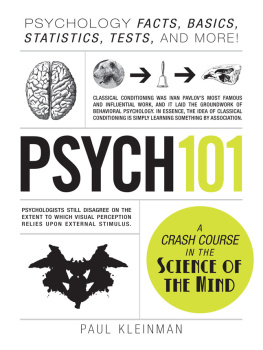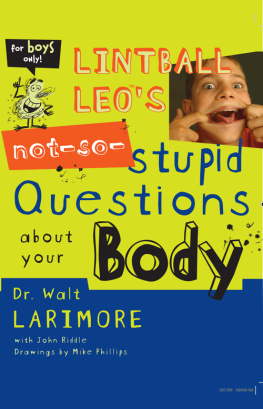Introduction
They say what doesnt kill you makes you stronger. I say what doesnt kill you doesnt exist.
Fellow hypochondriacs, neurotics, worrywarts, germaphobes, and self-diagnosing paranoid people, lend me your clean and disinfected ears! Are you tired of spending your days by the computer, reading webpage after webpage in a desperate attempt to find out what is wrong with you? Do you often hear people tell you to get out more or ask you when was the last time you went outside? Has anyone ever told you to not worry so much or that you should just touch the stupid subway pole because its not going to kill you? Well, with this book, you can do all of that! And more! Gone are the days where you type symptoms into a search bar and browse through your results. No longer will each click of the mouse jangle a new and different set of nerves! No Internet? No problem! You dont need the Internet to take care of your self-diagnosing needs! All youll ever need is the information youll find here!
Right now youre probably thinking to yourself, Can this book really be better than the Internet when it comes to researching my symptoms? Will I be able to find out useful information about medical disorders and conditions? Can this book help me identify the cause of a rash, lump, or deformity on any particular part of my body? What if I have pseudomonas folliculitis or something? Would the book be able to inform me of this? Well, dear reader, yes, yes, yes, and, yes! (And it might be a good idea to stay out of the hot tub for a while )
This book will go over various parts of your body in detail and describe what different symptoms and signs may mean. And to top it all off, this information is completely medically accurate and has been reviewed by an actual doctor and naturopath. Thats right, I said reviewed by a doctor. You know, those people who are sick of seeing you at their office every day. Those people who have read about even more illnesses than you. In other words, what you hold in your hands is a hypochondriacs dream come true. So have a seat; get out your hand sanitizer; make sure your physician, dermatologist, and allergist are on speed dial; and find your happy place, because its time to start self-diagnosing. And really, no matter what anyone tells you, those subway poles are seriously a breeding ground for disease.
Part 1
The Head
CHAPTER 1
Hair
Your hair can tell a lot about you, and it has nothing to do with the way you style it. Are you going prematurely gray? Is your hair dry and brittle? Is it falling out in patches? Is it falling out everywhere? What your hair looks and feels like can actually inform you of certain health problems, and sometimes the signs can be as subtle as that pitch-black mohawk you sported as a teenager. So if your hair is talking to you, youd better listen up! If you dont treat your hair properly now, the only style youll be showing off in the long run is a baseball cap and shiny scalp.
IF YOUR HAIR
falls out all over
You may be overstressed. Diffuse hair loss is a symptom of telogen effluvium, a common disorder caused by hormones kicked up by big changes in peoples lives. Just about anything worrying can start it, from a single distressing eventlike a death in the familyto more prolonged, daily anxiety caused by the economy, work, or chronic illness. A most indiscriminate and nonfatal condition, it can occur in men and women of any age or race. You may notice an unusual amount of hair on your brush, in the shower drain trap, or falling freely when you run your hand through your hair. Depending on the trigger, it can be acute and reverse itself within six months or it can be chronic and persistent. General medical treatment of acute cases recommends stress-relief exercises, patience, and a big hat if youre really that embarrassed.

Telogen effluvium
falls out in patches
You may be experiencing symptoms of cicatricial alopecia or alopecia areata. If the cause is cicatricial alopecia, you must treat any inflammation immediately as it causes scarring that will prevent your hair from growing back. Alopecia areata, an autoimmune disorder often linked to thyroid diseases, is less serious; though you will lose your hair, it will eventually grow back. You may also be experiencing male- or female-pattern baldness, in which case its wise to stock up on the usual hair regeneration shampooor at least a classy wig or toupee.
is dry and brittle
You may be anorexic, bulimic, or experiencing symptoms of hypothyroidism or hypoparathyroidism. In hypothyroidism, the body is less capable of metabolizing food and creating energy, which dries out your skin and hair. In hypoparathyroidism, calcium levels fall and phosphorous levels rise due to a lack of the parathyroid hormone, which regulates the calcium and phosphorus levels in extracellular fluid. This drop in calcium, especially if you also have poor absorption of vitamin D, dries out your hair. If youre suffering from anorexia or bulimia, youre not ingesting enough or youre throwing up, so your body isnt getting enough of the nutrients, proteins, and omega-3 fatty acids that it needs. This lack of nutrients is responsible for making your hair dry and brittle. One way or another, youre not getting enough of something, whether its hormones, nutrients, or moisturizing shampoo.
seems thicker
If youre a woman, you may be pregnant. In a normal hair cycle, your hair grows about half an inch per month for two to six years. Then your hair will rest for around two or three months, and fall out. At any time, 90 percent of the hair on your head is in the growing phase and 10 percent of your hair is in the resting phase. When a woman becomes pregnant, the percent of hair in the resting phase can increase by up to 60 percent. This means less hair falls out, and you start looking like you belong in a shampoo commercial. Of course, pregnancy hormones can also give you hair in places you never had hair before, like your stomach, back, and breasts. After giving birth, the resting phase of your hair will become shorter and it may appear as though your hair is thinner than normal (because more hair is falling out). As your new hair grows in, your hair cycle will become normal again, which is something you wont be able to say about your sleep cycle.
is growing in places that it shouldnt grow
If youre a woman, you may have what is known as hirsutism. This is when women have male-pattern hair growth, such as coarse, pigmented hair growing on the face, back, and chest. Hirsutism may be caused by a family trait or by excess androgens (male hormones) such as testosterone. When extremely high levels of androgens are enough to cause hirsutism, other symptoms may appear in a process known as virilization. These symptoms can include acne, balding, a decrease in the size of the breasts, a deepening of the voice, an increase in muscle mass, and an enlarged clitoris. If this happens to you, look on the bright side; you can always start a new career as a bearded lady.












